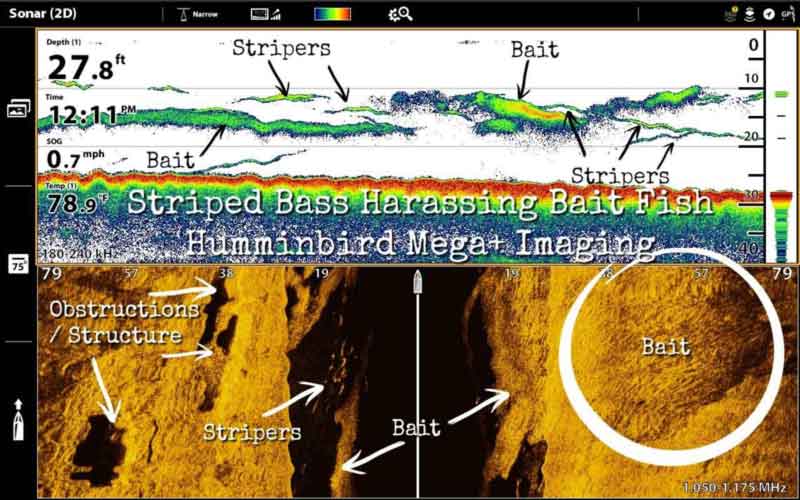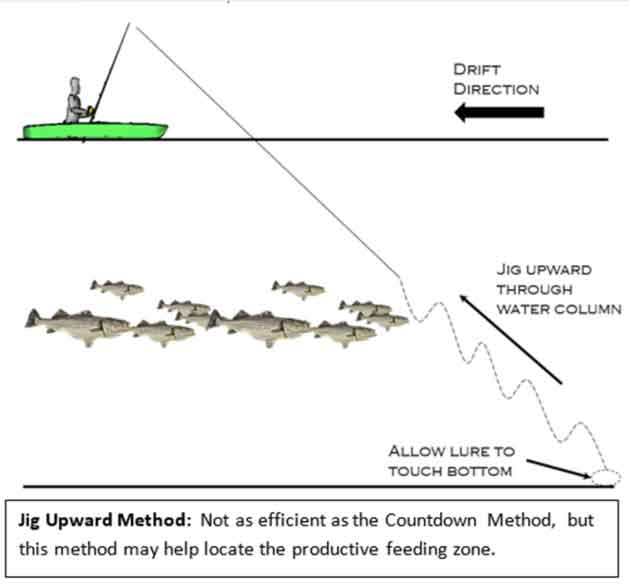With the water now warmed up for summer anglers will encounter fish suspended in the water column as a result of environmental factors, making summer trolling tactics and summer chumming effective... but not nearly as fun as jigging. Warming surface waters push the fish deeper, but lack of dissolved oxygen at depths pushes them upward, creating a narrow comfort band for the fish to occupy and for you to target. Anglers can easily identify this tight band by taking a peek at their fish finder, noting the various fish arches congregating at a specific depth.

A fish finder that shows well defined, crisp arches rather than amorphous blobs gives you the best shot at identifying and targeting these fish. Coupled with a Side Imaging unit like the Humminbird MEGA Imaging or 360 Imaging, now you can see not only the depth at which the fish reside, but also which direction to cast your jig. You may be able to upgrade your current unit with an aftermarket transducer to show crisp 2D images, but it’s simpler to get a great out-of-the-box setup that gives both sharp imagery and crisp 2D output, like the latest Helix or Solix Humminbird Mega+ models. But in spite of electronics putting a bullseye on the target, even accomplished anglers struggle in catching “suspenders” because of the difficulty in keeping a lure perfectly positioned in the strike zone without knowing it’s actually there.

How do you know the lure is in the strike zone? Well, getting a strike is a good indication, but obviously striped bass don’t feed all the time, even if the lure is placed with pinpoint accuracy. However, if you can’t consistently place the lure in the strike zone, there’s little hope of having a successful outing. With a few simple techniques, you’ll love encountering these fish because overcoming the extra challenge will leave your fishing buddies scratching their heads and green with envy. I’ll leave you with these simple techniques that anyone can learn in order to catch suspended fish.
Fishing the Countdown Method
I’ll start with my favorite method because if done properly, the jig stays in the strike zone the longest period of time. And of course, everyone knows, lures that stay in productive waters longer results in more and bigger fish.
Every jig has a fall rate, which can be most easily modified by adding a skirt or changing soft plastics that have a different profile. Once you know how fast the jig falls through the water, you can count the seconds until it hits the strike zone, shown by your electronics. Cast the lure and begin counting until you feel it touch bottom. If you’re in 20 feet of water and it takes 10 seconds to hit bottom, your lure falls at two feet per second. If you want to fish at 10 feet, once your lure hits the water, count to five and begin fishing. Repeat, repeat, repeat!

You can use methods other than counting down, especially while working a drift. These additional methods may take more time because the lure works its way through unproductive water before getting into the strike zone. However, this is sometimes the best way to find the zone in which they feed, so make sure you practice these techniques.
Jig Upward Method
The first of the drifting techniques is to cast out and allow the lure to touch bottom. As you drift, work the jig upward, taking an extra crank on the reel or do not allow the lure to fall as far with each bounce. Eventually you’ll have bounced the jig all the way back to the kayak or boat, at which point you can make another cast or you can reverse the process as shown in the next method.

Drop Down Method
This method merely reverses the previous example, and having a bait casting reel will prove its worth here. Drop the lure in the water and let out some line until you can jig without the lure popping out of the water. Bounce it a few times and let out line. With a bait casting reel, a simple push of a button can accomplish this. You can let line out using a spinning reel, but the process adds extra, cumbersome steps. Continue letting out line until a fish takes the lure or until you hit bottom. Once again, you can repeat the process or reverse the process. Repeat until you’ve dialed in on what the fish want and then just keep stubbornly doing the same thing.

- By Alan Battista
Proper presentation is king, and jigging is a highly nuanced skill of which we’re barely scratching the surface here. For more skills, tactics, and situations check out Battista’s book “Light Tackle Kayak Jigging the Chesapeake Bay,” sampled for this article.
- For more intel on mid-summer jigging, see Jigging for Dog Day Summer Stripers. For a refresher on releasing the fish properly with the water temperature up (which raises mortality rates especially when fish aren't handled properly), see Summer Catch and Release.